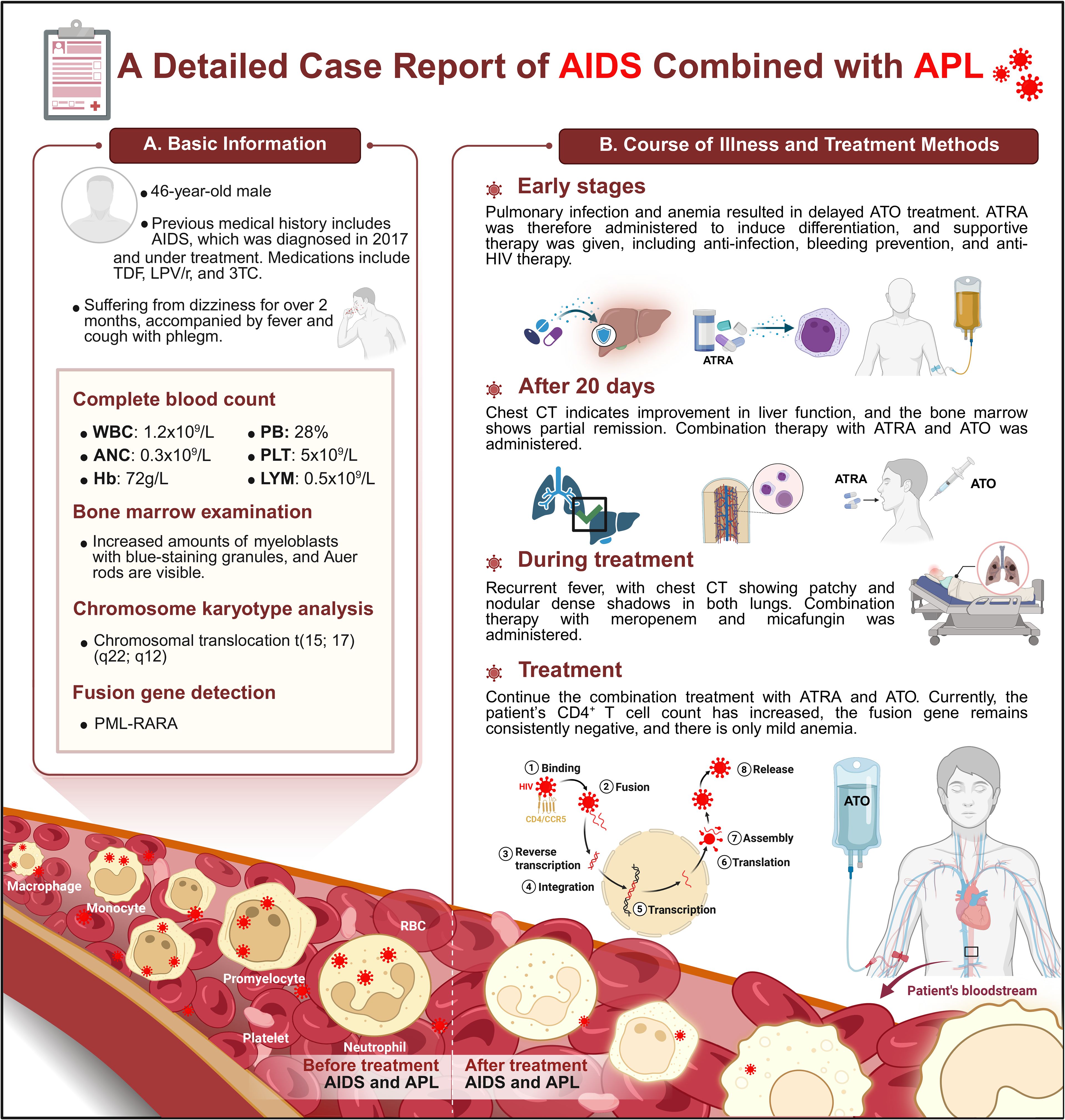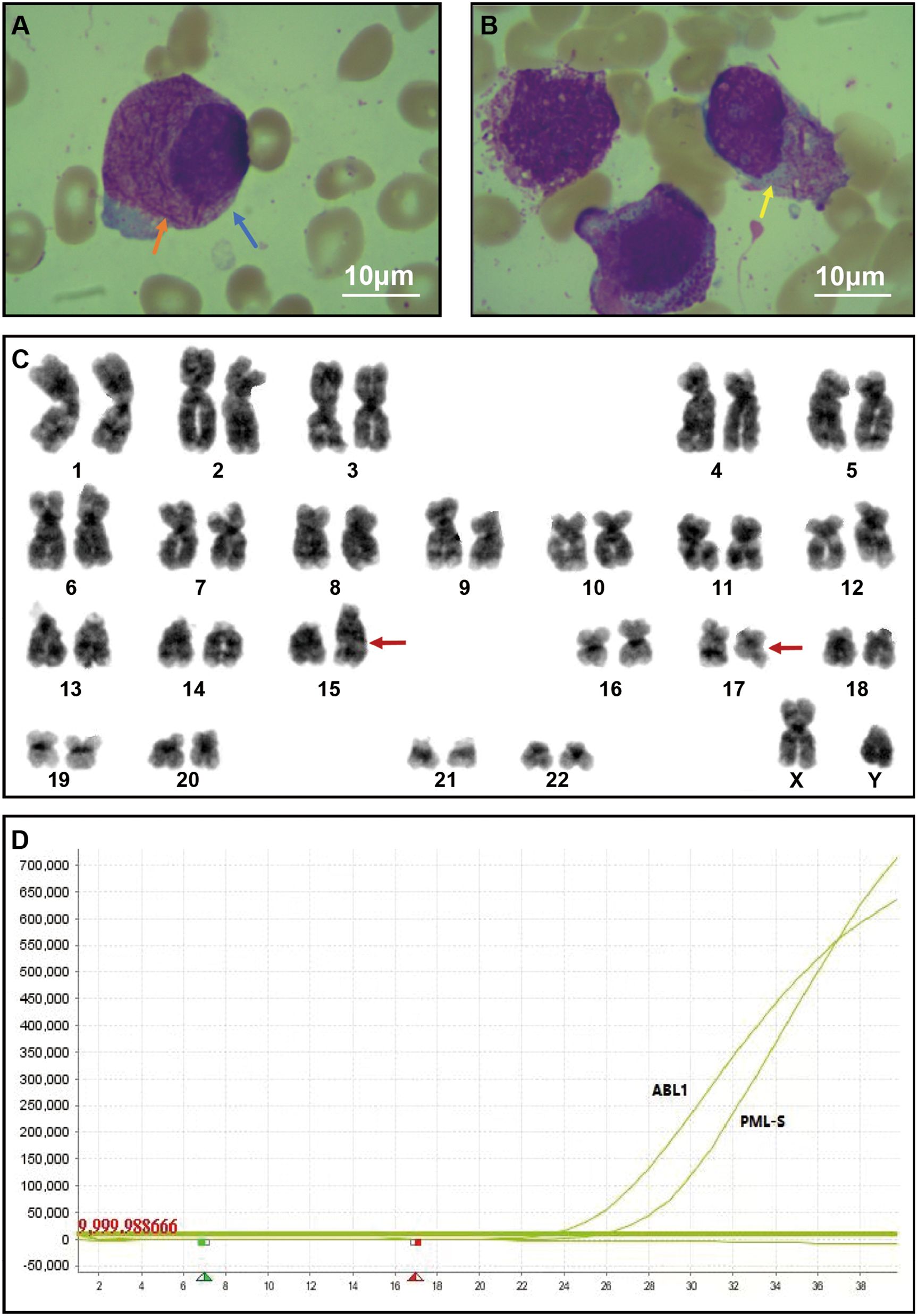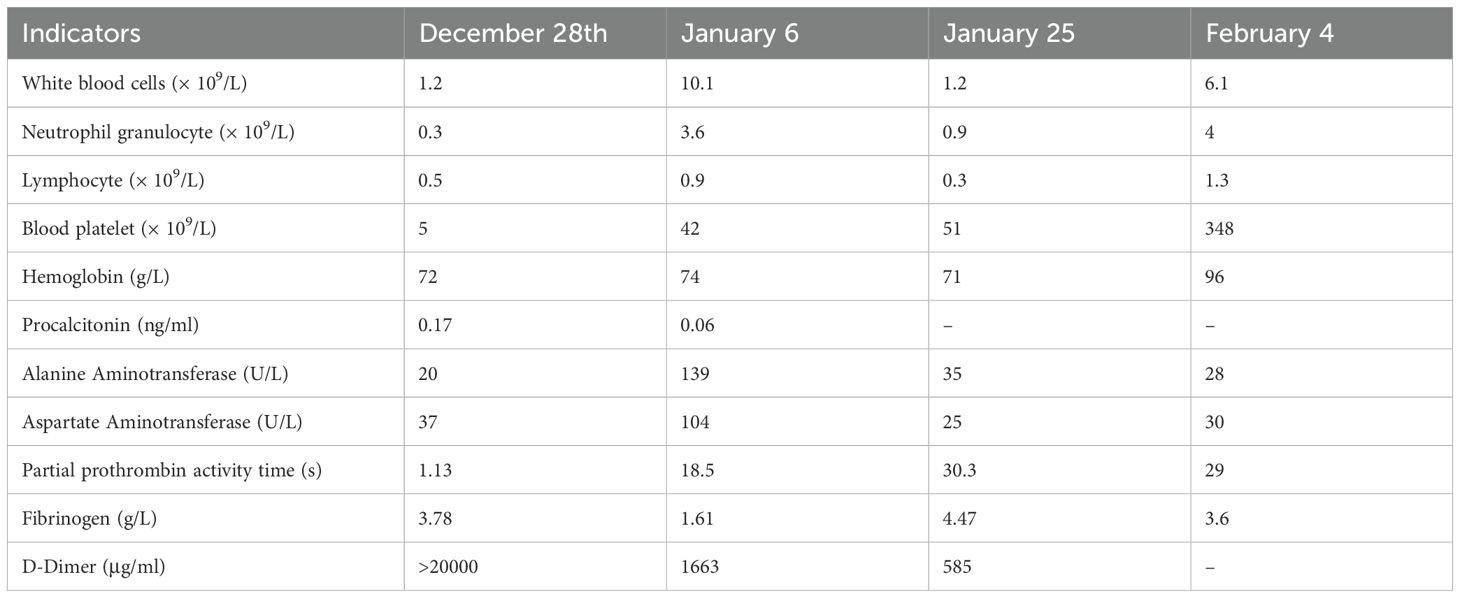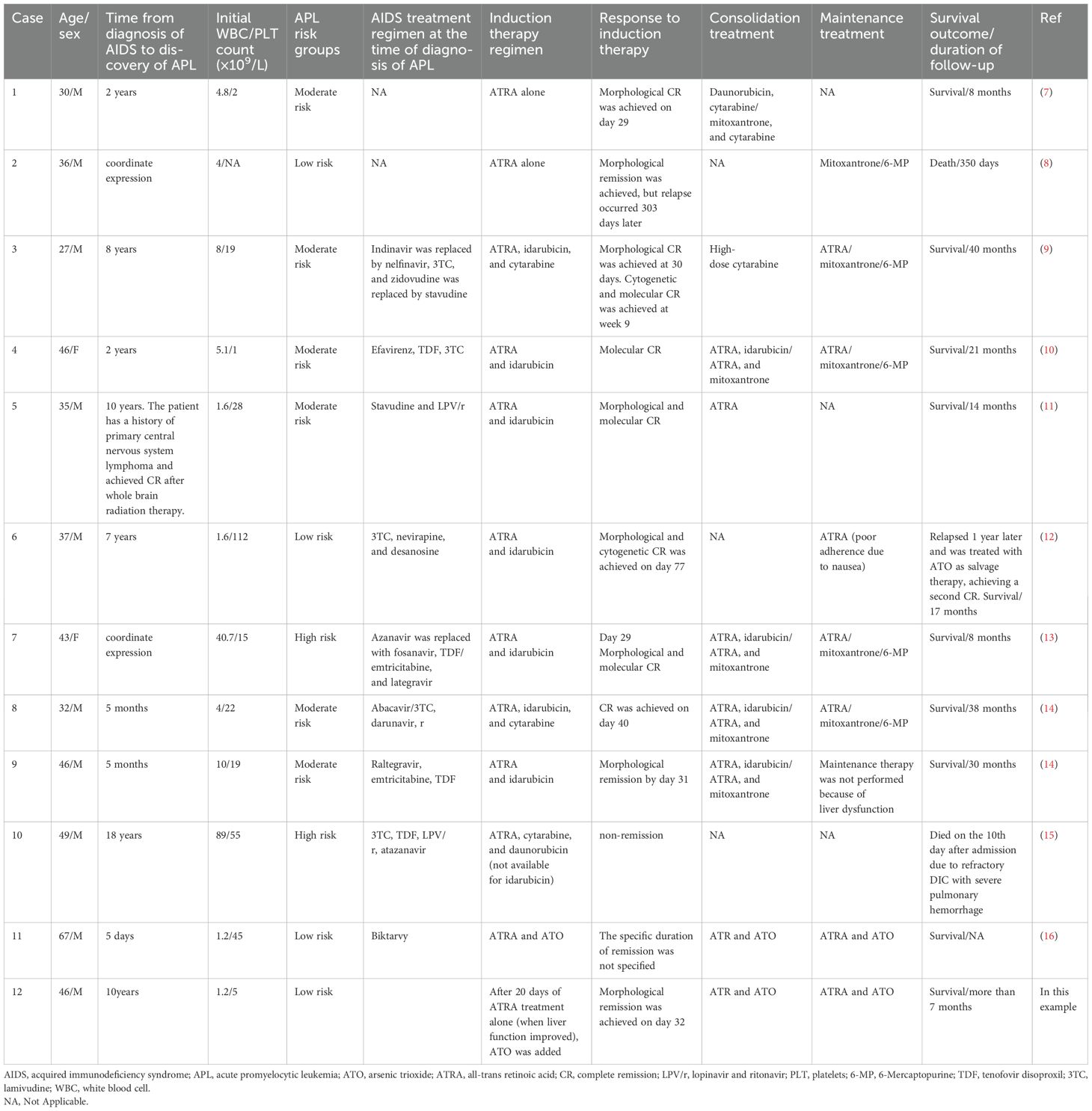- 1Department of Hematology, Yuyao People’s Hospital of Zhejiang Province, The Affiliated Yangming Hospital of Ningbo University, Yuyao, Zhejiang, China
- 2Department of Clinical Medicine, Hangzhou City University, Hangzhou, Zhejiang, China
Acute promyelocytic leukemia (APL) is a rare and aggressive subtype of acute myelogenous leukemia (AML), characterized by the PML-RARA fusion gene. When APL presents concurrently with acquired immunodeficiency syndrome (AIDS), it creates unique challenges in diagnosis and treatment due to the immunocompromised state of the patient. This case report describes a 46-year-old male patient with long-standing AIDS who developed APL. Initial treatment involved all-trans retinoic acid (ATRA) monotherapy due to the patient’s severe lung infection and liver dysfunction, followed by the addition of arsenic trioxide (ATO) once infection and liver function improved. The patient achieved complete remission (CR) after combined ATRA and ATO therapy, with successful molecular remission of the PML-RARA fusion gene. We discuss the complexity of managing APL in the context of HIV infection, including the challenges posed by infections, liver dysfunction, and the impact of chemotherapy on antiretroviral therapy (ART). This case highlights the need for immediate initiation of ATRA in APL patients, even before genetic confirmation, and the potential therapeutic role of ATO in both leukemia treatment and HIV reservoir management. Further studies are needed to optimize treatment protocols for patients with concurrent AIDS and APL, focusing on personalized approaches to maximize efficacy while minimizing complications.
1 Introduction
Acquired immunodeficiency syndrome (AIDS) is a severe immunodeficiency disease caused by human immunodeficiency virus (HIV) infection, which predisposes patients to various malignancies (1). Acute promyelocytic leukemia (APL) is a specific subtype of acute myelogenous leukemia (AML), characterized by a chromosomal translocation t(15;17)(q22;q12), resulting in the formation of the PML-RARA fusion gene. This fusion protein blocks cell differentiation and inhibits apoptosis, representing the primary molecular mechanism underlying APL (2, 3). APL typically affects young and middle-aged individuals, with a mean onset age of 44 years. It accounts for 10% to 15% of AML cases, with an incidence rate of approximately 0.23 per 100,000 (2). As a distinct AML subtype, APL presents unique clinical features and treatment responses. When AIDS and APL occur simultaneously, the complexity of diagnosis and treatment increases significantly, posing significant clinical challenges.
2 Case report
A 46-year-old male patient, living with HIV infection for over a decade, had not received treatment for four consecutive years after his diagnosis (Figure 1). The patient self-reported that in 2017, diagnostic findings confirmed progression to the AIDS stage, prompting initiation of antiretroviral therapy (ART). During this period, the patient underwent viral load and CD4+ T-cell count monitoring at the local CDC in their hometown; however, specific reports are unavailable. The patient self-reported a CD4+ T-cell count of approximately 300 cells/μL during ART, still indicating incomplete immune reconstitution. The current treatment regimen comprises tenofovir (TDF), lopinavir/ritonavir (LPV/r), and lamivudine (3TC). In December 2023, the patient presented with dizziness lasting over two months, accompanied by fever, cough, and sputum for two days. A routine blood test revealed a 28% blast cell population in peripheral blood, leading to his immediate hospitalization. Complete bone marrow analysis indicated an increase in promyelocytes, with visible azurophilic granules and Auer rods, suggestive of APL (Table 1) (Figures 2A, B). The diagnosis was confirmed by flow cytometry and positive PML-RARA fusion gene results (Figures 2C, D).

Figure 1. Management of acute promyelocytic leukemia in a patient with AIDS: a case study. (A) Preliminary diagnosis and basic information. A 46-year-old male with HIV infection for over a decade, untreated for four consecutive years post-diagnosis, progressed to AIDS in 2017. In December 2023, the patient presented with dizziness lasting over two months and fever with cough for two days. After comprehensive testing, including routine blood and bone marrow analysis and genetic examination, acute promyelocytic leukemia (APL) was diagnosed, confirmed by a specific chromosomal translocation t(15;17)(q22;q12) resulting in the PML-RARA fusion gene. (B) Disease evolution and treatment process. Upon admission, the patient’s severe lung infection and anemia delayed the initiation of ATO intravenous chemotherapy. As his condition improved, ATO chemotherapy was started in combination with oral ATRA induction therapy. However, the patient soon developed a fever, and chest CT revealed multiple patchy and nodular densities in both lungs, prompting the discontinuation of ATO and the introduction of anti-infection treatment with meropenem and micafungin. After induction therapy, bone marrow examination confirmed morphological remission. ATO and ATRA therapy was resumed, and subsequent tests showed a negative PML-RARA fusion gene, achieving complete remission. The patient remains in good condition under ongoing treatment. AIDS, acquired immunodeficiency syndrome; APL, acute promyelocytic leukemia; ATO, arsenic trioxide; ATRA, all-trans retinoic acid; LPV/r, lopinavir and ritonavir; TDF, tenofovir disoproxil; 3TC, lamivudine.

Figure 2. Diagnostic findings in acute promyelocytic leukemia: a case report. (A, B) Bone marrow examination revealed an increase in promyelocytes (blue arrow in A), with some hyper granularity with azurophilic granules (yellow arrow in B) with Auer rods visualized (orange arrow in (A)). (C) Cytogenetic analysis by G-banding showed the karyotype: 46, XY, t(15;17)(q22;q21), wherein chromosomal translocations are visually marked by red arrows. (D) The presence of the mutant PML-RARA fusion gene was confirmed through fluorescent PCR analysis.
Upon admission, the patient’s CD4+ T-cell count was measured at 329.6 cells/μL (indicating moderate immunosuppression), accompanied by severe pulmonary infection, along with prolonged prothrombin time and activated partial thromboplastin time due to APL, elevated D-dimer levels, granulocytopenia, thrombocytopenia, anemia, and other signs suggestive of disseminated intravascular coagulation (4). Given that the patient was stratified as low-risk for APL prognosis, Treatment was initiated with all-trans retinoic acid (ATRA) (25mg·m-2·d-1) to induce differentiation (while deferring arsenic trioxide (ATO) (0.16mg·kg-1·d-1) due to the severe lung infection). Simultaneously, supportive therapies were administered, including anti-infective measures, bleeding prevention, multiple plasma and platelet transfusions, and anti-HIV treatment. The patient subsequently developed liver dysfunction and leukocytosis (white blood cell count exceeding 10×109/L), prompting adjustments in treatment strategy. Concurrently, the patient received comprehensive supportive care comprising: cefotaxime 2.0g IV q12h, piperacillin-sulbactam 4.5g IV q8h (escalated from cefotaxime based on clinical suspicion of extended-spectrum beta-lactamase (ESBL)-producing pathogens), and micafungin 100mg IV qd for antimicrobial prophylaxis; bleeding prevention measures; multiple fresh frozen plasma and platelet transfusions; and antiretroviral therapy for HIV comanagement. During the treatment course, the patient developed hepatotoxicity accompanied by leukocytosis (white blood cell count >10×109/L). Therapeutic interventions were escalated with hydroxyurea 0.5g PO bid (days 8–10 post-diagnosis) and idarubicin 8mg/m2 IV daily (days 9–11 post-diagnosis) for leukocyte cytoreduction, supplemented by hepatoprotective agents including ursodeoxycholic acid and glutathione infusion. Hydroxyurea (0.5g bid 8–10 days in the course of the disease) and idarubicin (8mg·m-2·d-1 Days 9–11 of the course of disease) were used to reduce leukocytosis, and liver protection measures were implemented. Follow-up exams showed improvement in the lung infection and normalization of liver function, with bone marrow tests performed on day 20 indicating partial remission.
The patient then began ATO (0.16mg·kg-1·d-1) intravenous chemotherapy combined with oral ATRA (25mg·m-2·d-1), continuing with the first treatment course for induction therapy. During this phase, he experienced fever again, and chest CT revealed patchy and nodular density shadows in both lungs. A regimen of meropenem and micafungin was administered, improving the infection, with serial monitoring of CD4+ T-cell counts revealing a nadir of 148.4 cells/μL on day 26 of the disease course. On day 33 of the disease course, a follow-up evaluation was performed. Continued induction therapy led to morphological remission in bone marrow. After another course of ATO (0.16mg·kg-1·d-1) and ATRA (25mg·m-2·d-1), the PML-RARA fusion gene turned negative, and the patient achieved complete remission (CR). At the end of the second treatment course, follow-up testing revealed a CD4+ T-cell count of 369.9 cells/μL. Currently, the patient is undergoing consolidation therapy, showing an increased CD4+ T-cell count, persistent fusion gene negativity, and only mild anemia.
3 Discussion
APL presents with severe clinical manifestations, with high risks of bleeding and embolism during onset and induction therapy, potentially leading to fatal outcomes. Over the past three decades, the standardized clinical use of ATRA and ATO has transformed APL into a curable leukemia without the need for hematopoietic stem cell transplantation (5, 6).
A review of 11 previously reported AIDS-related APL cases (7–16) highlights that most patients achieved remission with ATRA alone or in combination with chemotherapy (anthracyclines or arsenic) (Table 2). Only one high-risk patient succumbed to severe disseminated intravascular coagulation. Long-term remission was achieved in most cases through consolidation and maintenance therapy. One patient who discontinued ATRA due to nausea relapsed one year later but achieved a second CR following salvage therapy with ATO (12).
Given the high mortality associated with APL, immediate ATRA treatment is recommended based on cytological and clinical criteria, while awaiting genetic confirmation (3, 4). In this case, the patient’s severe lung infection and liver dysfunction posed risks for initial ATO combination therapy. Since 1986, Shanghai Ruijin Hospital has successfully utilized ATRA-induced differentiation therapy for APL, with a CR rate of 75% to 85% for ATRA alone (17). Therefore, we opted for ATRA monotherapy during the early treatment phase. After the infection and liver function improved, ATO was added, and ATRA was continued for one week, achieving morphological remission, as observed in two other cases treated with ATRA alone (7, 8).
In the consolidation phase, we continued ATRA combined with ATO. Given the patient’s history of HIV and long-term ART, we carefully evaluated whether this chemotherapy regimen might interfere with his HIV treatment. Previous studies indicate that while ATRA upregulates HIV mRNA transcription in infected human HL-60 cell lines, it does not increase viral replication due to blocked HIV mRNA translation and replication. This mechanism ultimately leads to the apoptosis of HIV-infected cells, reducing the proviral DNA load in a dose-dependent manner (18). Furthermore, ATRA significantly decreased viral replication in primary lymphocytes from HIV-infected patients, suggesting it may also serve as a therapeutic agent against HIV infection (19).
Research from the Chinese Academy of Sciences and Sun Yat-sen University showed that ATO specifically activates latent viral reservoirs without inducing excessive inflammation. In a simian immunodeficiency virus (SIV) model, ATO combined with ART significantly delayed viral rebound post-drug withdrawal, with some monkeys showing no viral rebound after 80 days (compared to 22 days for ART alone). ATO reduced viral reservoirs and enhanced virus-specific immune responses. Moreover, ATO downregulated the expression of CD4 and CCR5 receptors on CD4+ T-cells, essential for HIV entry, thus inhibiting new rounds of viral infection (20).
In conclusion, initiating ATRA treatment based on clinical and morphological criteria can significantly improve outcomes in APL patients, even in complex cases like this. Individualized treatment tailored to the patient’s condition may lead to better efficacy. For consolidation and maintenance therapy, further case studies and multicenter clinical trials are needed to confirm whether ATRA combined with ATO is the optimal approach. Continuous optimization of treatment protocols is essential to improve patient outcomes and quality of life.
Data availability statement
The original contributions presented in the study are included in the article/supplementary material. Further inquiries can be directed to the corresponding authors.
Ethics statement
Written informed consent was obtained from the individual(s) for the publication of any potentially identifiable images or data included in this article.
Author contributions
SD: Funding acquisition, Writing – review & editing. CA: Conceptualization, Writing – original draft. JS: Conceptualization, Visualization, Writing – original draft. HX: Visualization, Writing – review & editing. YX: Funding acquisition, Writing – review & editing.
Funding
The author(s) declare that financial support was received for the research and/or publication of this article. This study was supported by the Qiantang Scholars Fund in Hangzhou City University (Grant No. 210000-581835) and Natural Science Foundation of Zhejiang Province (Grant No. BY24H080010).
Acknowledgments
The authors would like to thank PubMed for the valuable information. Figure 1 was created by BioRender (biorender.com).
Conflict of interest
The authors declare that the research was conducted in the absence of any commercial or financial relationships that could be construed as a potential conflict of interest.
Generative AI statement
The author(s) declare that no Generative AI was used in the creation of this manuscript.
Publisher’s note
All claims expressed in this article are solely those of the authors and do not necessarily represent those of their affiliated organizations, or those of the publisher, the editors and the reviewers. Any product that may be evaluated in this article, or claim that may be made by its manufacturer, is not guaranteed or endorsed by the publisher.
Abbreviations
AIDS, acquired immunodeficiency syndrome; AML, acute myeloid leukemia; APL, acute promyelocytic leukemia; ART, antiretroviral therapy; ATO, arsenic trioxide; ATRA, all-trans retinoic acid; CR, complete remission; ESBL, extended-spectrum beta-lactamase; HIV, human immunodeficiency virus; LPV/r, lopinavir and ritonavir; PLT, platelets; SIV, simian immunodeficiency virus; 6-MP, 6-Mercaptopurine; TDF, tenofovir disoproxil; 3TC, lamivudine; WBC, white blood cell.
References
1. Reid E, Suneja G, Ambinder RF, Ard K, Baiocchi R, Barta SK, et al. Cancer in people living with HIV, version 1.2018, NCCN clinical practice guidelines in oncology. J Natl Compr Cancer Network. (2018) 16:986–1017. doi: 10.6004/jnccn.2018.0066
2. Doctor Association; Chinese Medical Association, Chinese Medical Doctor Association. Chinese guidelines for diagnosis and treatment of acute promyelocytic leukemia (2018). Zhonghua xue ye xue za zhi = Zhonghua xueyexue zazhi. (2018) 39:179–83. doi: 10.3760/cma.j.issn.0253-2727.2018.03.002
3. Pollyea DA, Altman JK, Assi R, Bixby D, Fathi AT, Foran JM, et al. Acute myeloid leukemia, version 3.2023, NCCN clinical practice guidelines in oncology. J Natl Compr Canc Netw. (2023) 21:503–13. doi: 10.6004/jnccn.2023.0025
4. Dou XL, Zhao T, Xu LP, Zhang XH, Wang Y, Chen H, et al. Age-related clinical characteristics and prognosis in non-senile adults with acute myeloid leukemia. Zhonghua Xue Ye Xue Za Zhi. (2018) 39:969–76.
5. Shen ZX, Shi ZZ, Fang J, Gu BW, Li JM, Zhu YM, et al. All-trans retinoic acid/As2O3 combination yields a high quality remission and survival in newly diagnosed acute promyelocytic leukemia. Proc Natl Acad Sci U S A. (2004) 101:5328–35. doi: 10.1073/pnas.0400053101
6. Hu J, Liu YF, Wu CF, Xu F, Shen ZX, Zhu YM, et al. Long-term efficacy and safety of all-trans retinoic acid/arsenic trioxide-based therapy in newly diagnosed acute promyelocytic leukemia. Proc Natl Acad Sci U S A. (2009) 106:3342–7. doi: 10.1073/pnas.0813280106
7. Calvo R, Ribera JM, Battle M, Sancho JM, Granada I, Flores A, et al. Acute promyelocytic leukemia in a HIV seropositive patient. Leukemia lymphoma. (1997) 26:621–4. doi: 10.3109/10428199709050899
8. Sutton L, Guénel P, Tanguy ML, Rio B, Dhedin N, Casassus P, et al. Acute myeloid leukaemia in human immunodeficiency virus-infected adults: epidemiology, treatment feasibility and outcome. Br J haematology. (2001) 112:900–8. doi: 10.1046/j.1365-2141.2001.02661.x
9. Kudva GC, Maliekel K, Richart JM, Batanian JR, Grosso LE, Sokol-Anderson M, et al. Acute promyelocytic leukemia and HIV-1 infection: case report and review of the literature. Am J Hematol. (2004) 77:287–90. doi: 10.1002/ajh.20192
10. De Vita S, De Matteis S, Laurenti L, Sorà F, Tarnani M, Cingolani A, et al. Acute promyelocytic leukemia in an HIV-infected patient: a case report. Am J Hematol. (2006) 81:300.
11. Boban A, Radman I, Zadro R, Dubravcic K, Maretic T, Civljak R, et al. Acute promyelocytic leukemia after whole brain irradiation of primary brain lymphoma in an HIV-infected patient. Eur J Med Res. (2009) 14:42–3. doi: 10.1186/2047-783X-14-1-42
12. Malik A and Levine RL. The first case report of APL (ACUTE PROMYELOCYTIC LEUKEMIA) in an HIV positive patient on (Highly active antiretroviral therapy) treated with ARSENIC TRIOXIDE. Blood. (2009) 114:4166–6. doi: 10.1182/blood.V114.22.4166.4166
13. Drilon AD, Gamboa EO, Koolaee R, and Goel A. Acute promyelocytic leukemia in HIV-infected adults: a case report and review of therapeutic considerations. Clin lymphoma myeloma leukemia. (2010) 10:E47–52. doi: 10.3816/CLML.2010.n.075
14. Kunitomi A, Hasegawa Y, Lmamura J, Yokomaku Y, Tokunaga T, Miyata Y, et al. Acute promyelocytic leukemia and HIV: case reports and a review of the literature. Internal Med (Tokyo Japan). (2019) 58:2387–91. doi: 10.2169/internalmedicine.1662-18
15. Mendes-de-Almeida DP, Fernandez TS, Lovatel VL, da Rocha MM, Gomes BE, Monte-Mór BCR, et al. Acute promyelocytic leukemia in a long-standing HIV-positive patient: Case report and literature review. Leukemia Res Rep. (2022) 18:100339. doi: 10.1016/j.lrr.2022.100339
16. Mahmoud A, Ghrewati M, Kania B, Naseer M, Kapoor A, and Michael P. Aleukemic acute promyelocytic leukemia: how concomitant HIV, hepatitis C, and chronic alcohol use disorder may have hidden an underlying Malignancy. Am J Case Rep. (2023) 24:e938086. doi: 10.12659/AJCR.938086
17. Wu J, Lu AD, Zhang LP, Zuo YX, and Jia YP. Study of clinical outcome and prognosis in pediatric core binding factor-acute myeloid leukemia. Zhonghua xue ye xue za zhi = Zhonghua xueyexue zazhi. (2019) 40:52–7.
18. Semmel M, Macho A, Coulaud D, Alileche A, Plaisance S, Aguilar J, et al. Effect of retinoic acid on HL-60 cells infected with human immunodeficiency virus type 1. Blood. (1994) 84:2480–8. doi: 10.1182/blood.V84.8.2480.2480
19. Maeda Y, Yamaguchi T, Hijikata Y, Morita Y, Tanaka M, Hirase C, et al. All-trans retinoic acid attacks reverse transcriptase resulting in inhibition of HIV-1 replication. Hematol (Amsterdam Netherlands). (2007) 12:263–6.
Keywords: acute promyelocytic leukemia (APL), acquired immunodeficiency syndrome (AIDS), all-trans retinoic acid (ATRA), arsenic trioxide (ATO), PML-RARA fusion gene
Citation: Ai C, Shentu J, Xu H, Xia Y and Duan S (2025) Co-occurrence of AIDS and acute promyelocytic leukemia: a case report and review of the literature. Front. Hematol. 4:1527938. doi: 10.3389/frhem.2025.1527938
Received: 14 November 2024; Accepted: 26 June 2025;
Published: 15 July 2025.
Edited by:
Stefano Molica, Hull University Teaching Hospitals NHS Trust, United KingdomReviewed by:
Raffaele Palmieri, University of Rome Tor Vergata, ItalyDaniela P. Mendes-de-Almeida, Oswaldo Cruz Foundation (Fiocruz), Brazil
Copyright © 2025 Ai, Shentu, Xu, Xia and Duan. This is an open-access article distributed under the terms of the Creative Commons Attribution License (CC BY). The use, distribution or reproduction in other forums is permitted, provided the original author(s) and the copyright owner(s) are credited and that the original publication in this journal is cited, in accordance with accepted academic practice. No use, distribution or reproduction is permitted which does not comply with these terms.
*Correspondence: Yongming Xia, eHltMjAyNDZAMTYzLmNvbQ==; Shiwei Duan, ZHVhbnN3QGh6Y3UuZWR1LmNu
†These authors have contributed equally to this work
 Cheng Ai1†
Cheng Ai1† Jianqiao Shentu
Jianqiao Shentu Yongming Xia
Yongming Xia Shiwei Duan
Shiwei Duan
